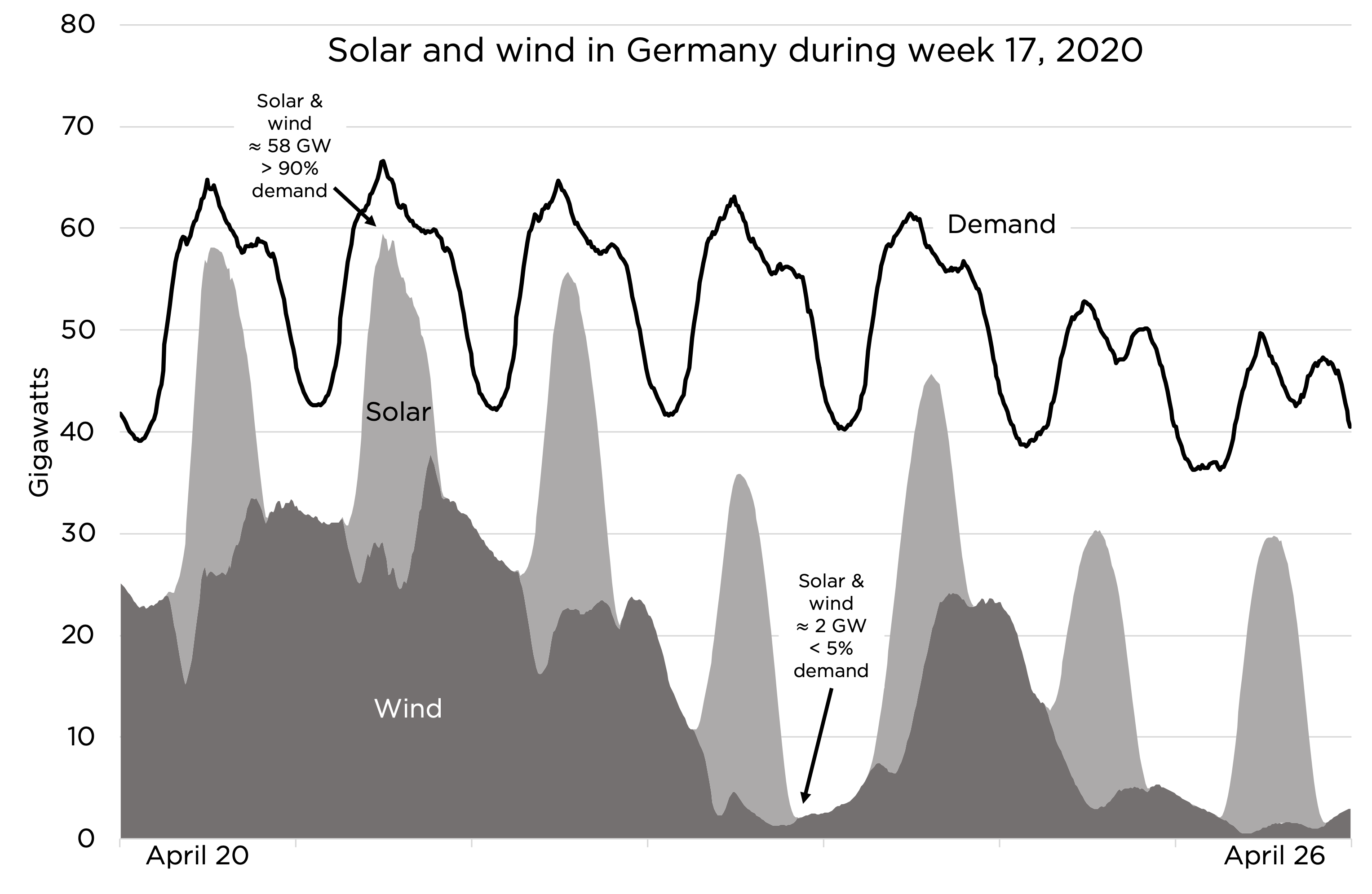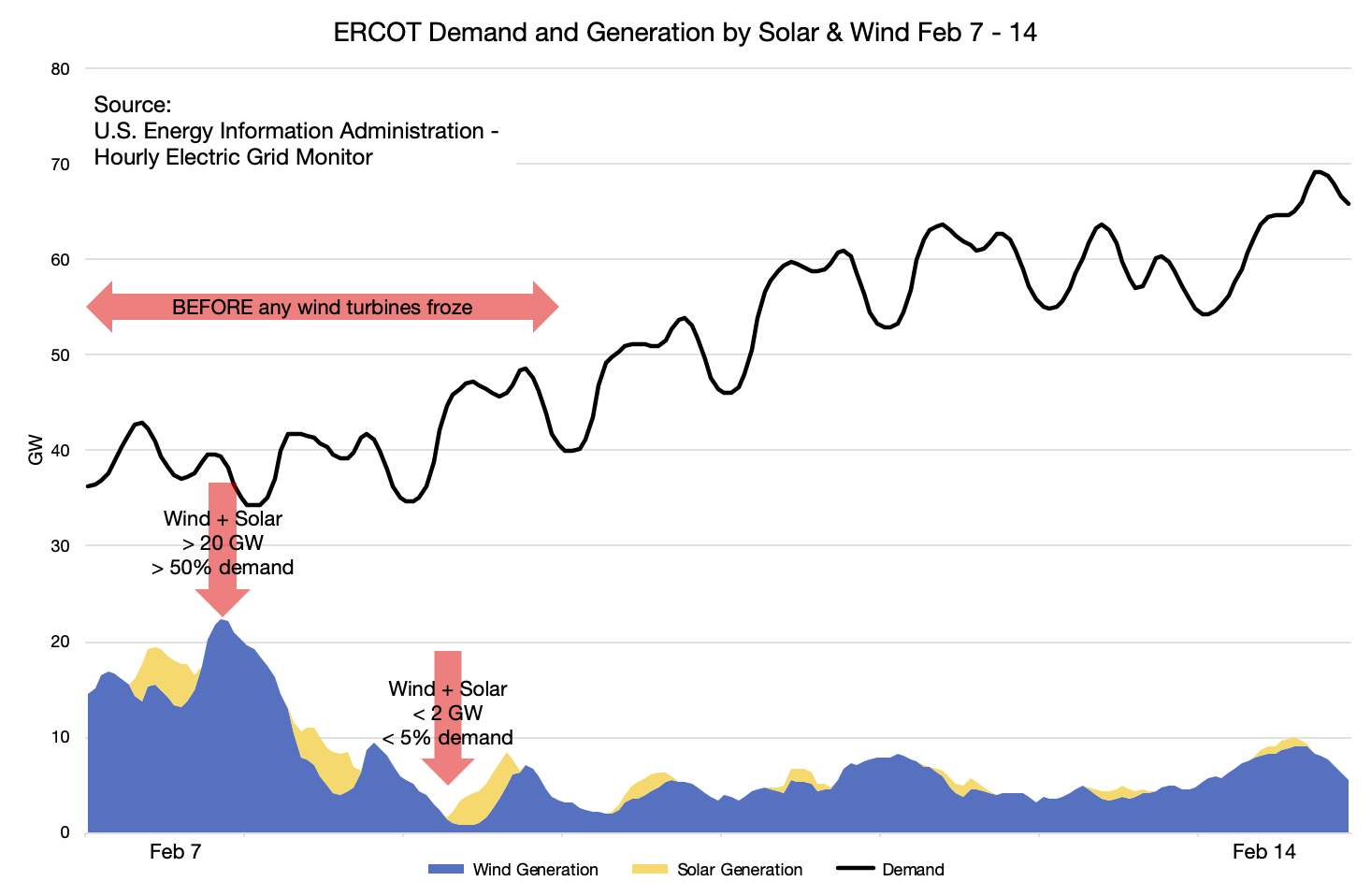The reconciliation bill’s goal of 80% "clean electricity" by 2030, which has still not been abandoned, would mean going from 10% unreliable solar+wind to a catastrophic 50% solar+wind in 8 years.
Quick Summary
- Now that the disastrous Clean Electricity Performance Program is gone from the reconciliation bill, many think our grid is safe. Not true. Dem leaders are still committed to the CEPP's goal of "80% clean" through other means, saying "there's more than one way to skin a cat."1

-
The reconciliation bill still contains many provisions to pursue the goal of "80% clean electricity" by 2030--including a 10-year increase of the solar and wind subsidies that have already made American electricity far less reliable and affordable.2
-
"80% clean electricity by 2030" is a misleading goal, because it implies that many sources of energy are allowed. In reality, because nuclear in the US is virtually criminalized and hydro is opposed as well, 80% clean electricity means >50% solar and wind.
https://twitter.com/AlexEpstein/status/1446554729169915907
-
Right now about 40% of American electricity is "clean," with unreliable solar and wind providing about 10%. Given nuclear and hydro realities in the US, 80% "clean" by 2030 means quintupling unreliable solar and wind, from 10% to 50% of our electricity in 8 years!
-
Every area of the world that has tried using significant amounts of unreliable solar and wind has had major cost and/or reliability problems. In the US, we have had big electricity price increases and huge reliability problems even at 10% solar and wind.
-
Not only are there high power prices in CA (<20% generated solar+wind), Germany (>33% solar+wind), and Denmark (~50% solar+wind)--but these places would be far worse if not for an ability the US can't have: the ability to import and export huge amounts of electricity.3

-
Tiny Denmark not only has ultra-expensive electricity, it can only function at all with ~50% solar+wind because it imports power from neighbors when the wind dies down. In 2019 it imported 50% as much power as it generated. Imagine the US trying to do that with Canada and Mexico!4
-
Denmark also depends on large neighbors to be able to handle its excess electricity when there is too much wind for Denmark's electricity needs. In 2019 Denmark exported 30% as much power as it generated. Can Canada and Mexico absorb an erratic 30% of the power we generate?
-
Germans, to get 37% of their electricity from solar+wind, have doubled their prices--now 3X US prices. And they can only get away with 37% because they have neighbors to bail them out when solar/wind fall short. The US as a whole has no such neighbors.5

-
Germany is currently starving for more Russian coal and gas, at skyrocketing prices, in expectation of a cold winter and with more nuclear capacity shutdowns looming by end of the year. They're paying the price for listening to solar+wind propagandists.6
-
In California, where I live, we get <20% of our electricity from domestic wind and solar--and we have skyrocketing prices along with disastrous shortages and blackouts. And it would be far worse if we didn't import 30% of our electricity from neighbors.7
-
During TX's February cold spell, wind and solar disappeared when they were needed the most. Its expensive batteries, which couldn't even store minutes worth of electricity, didn’t help, either. What would they have done under the 50% solar and wind??!!

-
No place in the world gets a large share of its electricity from solar and wind without huge imports from its neighbors' reliable--not solar+wind--power plants. For the US, which cannot import a lot of electricity, the reconciliation bill's 50% solar+wind is catastrophic.
-
The facts are clear. 10% solar and wind in the US is disastrous. 50+% solar and wind would guarantee unaffordable prices, constant shortages, frequent blackouts--and the fleeing of industry and jobs, once companies realize the US no longer has low-cost, reliable electricity.
-
Our government's push for mandating 50+% unreliable solar and wind plays perfectly into the hands of China. China has a clear strategy of running its economy on 84% fossil fuels, while encouraging us to run on unreliable solar and wind—that is made using Chinese fossil fuels.8
-
The claim that the US pursuing 50% solar+wind will lower global CO2 emissions is a joke. As China illustrates, the developing world will continue to use more and more fossil fuel because that is by far the lowest-cost way for it to get reliable energy.9
-
Anyone who cares about CO2 emissions must recognize that the only non-carbon energy source that has a chance of outcompeting fossil fuels and lowering global emissions is nuclear energy. Nuclear is incredibly safe, incredibly reliable, and can be generated anywhere in the world.
-
Any policy serious about CO2 emissions needs to recognize the severe deficiencies of wind/solar and make nuclear decriminalization priorities number 1, 2, and 3. Instead, the reconciliation bill does nothing to decriminalize nuclear and actually extends anti-nuclear subsidies!
-
Summary: The reconciliation bill's goal of "80% clean electricity by 2030" requires a catastrophic 50% unreliable solar+wind, while continuing and worsening the criminalization of nuclear. We must scrap this threat to American energy and create a bill to liberate American energy.
References
-
E&E News - ‘More than one way’: Dems mull options for climate program↩
-
Alex Epstein - Talking Points on the Wind Production Tax Credit↩
-
German household electricity prices have more than doubled to over 0.3€ per kWh ($0.35 per kWh depending on currency exchange rate) since 2000 when the modern renewable energy law started to massively incentivize solar and wind capacity on the German grid. BDEW Strompreisanalyse Jul 2021 p. 7
The average US household price in 2020 was $0.1315 per kWh. In California it was $0.2045 per kWh. U.S. Energy Information Administration Electric Power Annual table 5a
Increasingly, Germany depends on interconnections with neighboring countries. In 2020 the country experienced a sharp increase in electricity imports, while still massively exporting solar and wind overproduction.
Reuters - German power export surplus shrank 46.2% in 2020Alex Epstein - Energy Talking Points on California Blackouts↩
-
Public generation of electricity was over 488 terawatt-hours in Germany for 2020, solar and wind combined generated over 37%. In 2002 they generated just over 3%.
Fraunhofer ISE energy-charts.de
German household electricity prices have more than doubled to over 0.3€ per kWh ($0.35 per kWh depending on currency exchange rate) since 2000 when the modern renewable energy law started to massively incentivize solar and wind capacity on the German grid.
BDEW Strompreisanalyse Jul 2021 p. 7
The average US household price in 2020 was $0.1315 per kWh.
U.S. Energy Information Administration Electric Power Annual table 5a
Increasingly, Germany depends on interconnections with neighboring countries. In 2020 the country experienced a sharp increase in electricity imports, while still massively exporting solar and wind overproduction.
Reuters - German power export surplus shrank 46.2% in 2020↩ -
Yahoo finance - Europe Turns To Russia For More Coal As Energy Prices Skyrocket↩
-
China’s primary energy consumption from coal, oil, and natural gas was over 84% of the total in 2020.
BP Statistical Review of World Energy 2021China has a tight grip on many critical minerals in the rare earth category, controlling the mining of a large share and processing of close to 100% of them.
Power Hour - Maxwell Goldberg on Our Dangerous Material Dependence on ChinaInvestingnews.com - 10 Top Countries for Rare Earth Metal Production
Defensenews.com - The collapse of American rare earth mining — and lessons learnedIn 2019 more than 8 times as much solar PV module capacity was imported as manufactured in the US. Most of the US imports come from Southeast Asia and China has a tight grip on key mineral production, refining, and across the supply chains of components.
U.S. Energy Information Administration - Annual Solar Photovoltaic Module Shipments Report
U.S. Energy Information Administration - U.S. imports of solar photovoltaic modules mainly come from AsiaMark P. Mills - Green Energy’s Overseas Dependence
Mark P. Mills - If You Want ‘Renewable Energy,’ Get Ready to Dig↩
